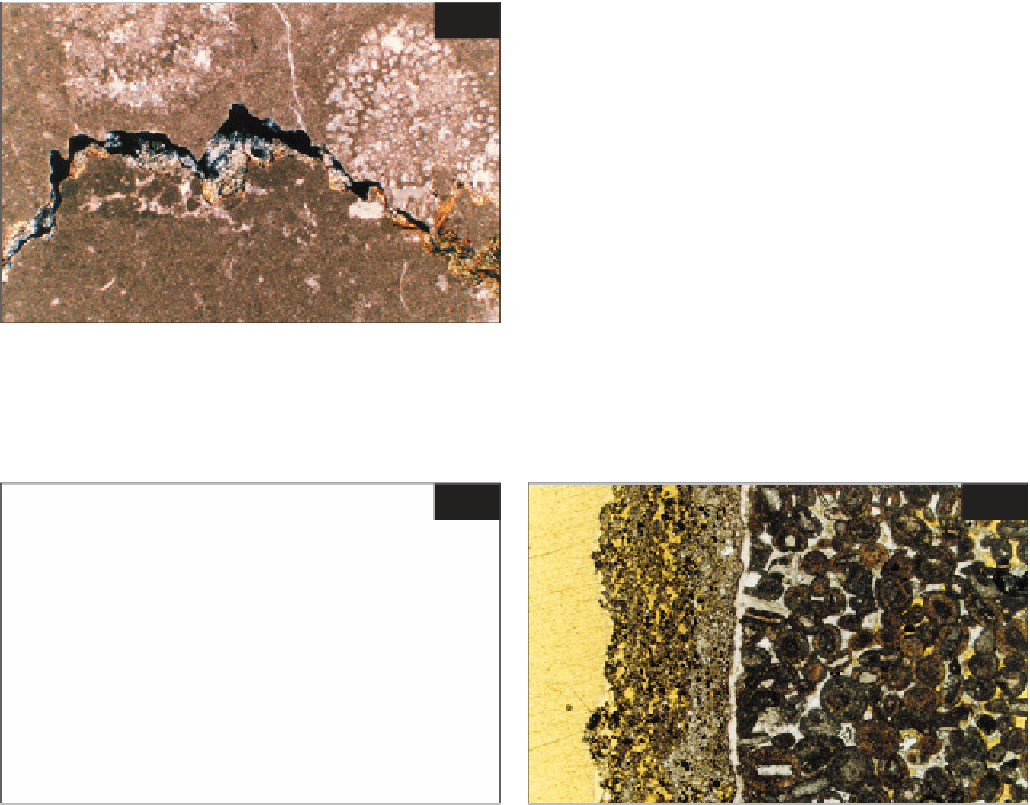Geoscience Reference
In-Depth Information
AND DECAY
cause stone unit failure. Stone containing these features
would normally be discarded. Other natural stone
features such as bedding planes, joints (see
32
) or
stylolites, also have the potential to act as planes of
weakness. These can be assessed in thin section to
determine the open width, the degree of wall contact, and
the types/stability of any filling material. Figure
88
shows 'Filetto Rosso' from Italy, which is a hard,
polishable, cream-coloured limestone (sparse biomicrite)
with red/pink stylolites. Stylolites are irregular suture-
like boundaries, generally running independently of the
bedding, which are present in some limestones. Figure
89
shows 'Vtratza' limestone from Bulgaria, which is a
compact, cream-coloured limestone (biomicrite), which
sometimes includes fossil burrows that are lined with
organic matter. These appear like knots in wood and
these 'knots' can fall out of the stone, leaving holes.
The most important stone decay mechanisms are salt
crystallization, attack by acid gases in the air, and frost
action (Ingham, 2005a). Salt crystallization occurs when
a solution of salt/s in water is deposited under drying
conditions on the surface of the masonry and/or within
its pores. The growth of the salt crystals is an expansive
process that causes powdering, scaling, and delamination
of the outer stone. Pollution from industry and transport
causes masonry decay by attack from acid gases in the
air. Sulfur (and nitrogen-based) gases react with moisture
to produce acidic solutions that can directly attack
calcareous stones. Exposed masonry surfaces are
dissolved away and salt crusts (often including
particulates and other dirt) are deposited on more
sheltered surfaces, giving a soiled appearance (
90
).
Despite its image as an eternal material, even good-
quality building stone has a limited life. Deterioration
and decay may result from inherent defects within the
stone, or more usually, from the processes of weathering
or attack from pollution. The causes and degree of stone
defects and decay are eminently suited to assessment by
petrographic examination.
Inherent flaws found within stones include fractures
and shakes, which act as planes of weakness and may
88
88
'Filetto Rosso' limestone (Italy) with a stylolite that
is partially open (black) and partially filled with clay
and iron minerals (orange); XPT, ×35.
89
90
89
View of 'Vtratza' limestone (Bulgaria) showing
organic matter (dark brown) lining a fossil burrow. The
sample has been stained in accordance with
Dickson's method; PPT, ×150.
90
Pollution crust consisting of gypsum and soot (left)
on a Portland limestone surface. Gypsum (white) also
fills the macropores near to the outer surface; PPT,
×35.





